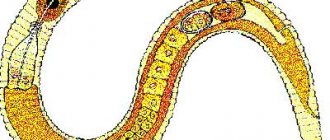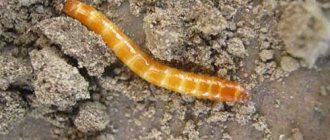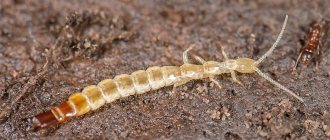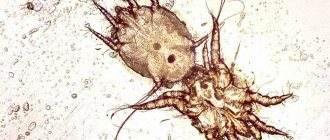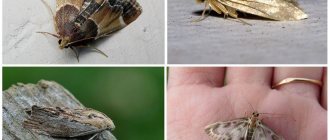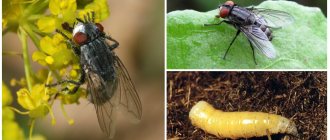Description of the pest
The parasite belongs to the type of round protostomal worms, reaching a size of 1 mm. In nature, there are more than twenty-five thousand species of nematodes, harmless or parasitic on plants, animals, and humans.
Several types of worms pose a danger to garden crops. The homeland of nematodes is the American continent; in European countries, potato nematodes appeared at the beginning of the 20th century, in Russia - in the late 40s of the last century. Found in all regions, they are distinguished by their invulnerability, vitality, and fertility.
Due to their microscopic size and underground habitat, it is difficult to notice the appearance of parasites on the plant. Usually visible signs appear at the stage when the bushes are seriously affected by the pest. Fighting worms is difficult due to their specificity:
- resistance to traditional insecticidal preparations;
- various ways of spread (infected seed tubers, through shoes and gardener's tools, through the air, through drops of precipitation);
- different habitats (as ectoparasites - on the roots of plants, as endoparasites - inside stems, leaf blades).
Worms damage roots and stems, which slows down the growth and development of plants and reduces germination. Deformations appear on potato tubers, they rot and become unsuitable for food. In all crops, immunity to infections decreases, while worms spread phytopathogenic organisms, contributing to the manifestation of viral diseases.
Parasites create entire colonies, actively reproduce, destroy plantings, and are carriers of diseases. Having discovered a pest on the site, it is necessary to immediately take all measures to exterminate it.
On a note! Practice shows that it is impossible to completely get rid of the pest due to the peculiarities of its biological development. An integrated, well-thought-out approach can only significantly reduce the population size and prevent a threat to the crop.
How to remove pests yourself?
To prevent worms from causing serious damage to plantings, it is necessary to fight in different ways. The use of agrotechnical, mechanical, biological and chemical methods is allowed. If you choose one remedy, the result may not be obtained immediately.
Agrotechnical method of control
At the same time, correct crop rotation and various activities are carried out. Thus, it is recommended to constantly alternate crops. Moreover, the seeds are regularly renewed. If you do this in parts, the result will be excellent, and the method itself is not expensive. It is not recommended to plant potatoes in the same place next year; it is better to return to them after 3-4 years.
If the number of nematodes does not exceed 3-5 cysts per 100 cm³ of soil, then the pest has almost no effect on potatoes.
The fight against the harmful potato nematode is carried out by planting varieties resistant to this worm:
- Impapa
- Aspia
- Carlina
- Panda
- Red Scarlet
- Sante.
They are alternated with unstable varieties. It is recommended to nourish the soil with fertilizers: Kemira; superphosphate; ash; Bulba remedy; “Potato” is universal.
Biological method
This option involves the need to plant certain types of plants: marigolds, calendula, nasturtium, beans, sweet clover. With their help, the number of pests is reduced. Such control methods are combined with the placement of organic material in the soil. At the same time, the activity of annelids intensifies. They are the main enemies of nematodes.
Chemical method
Treatment should be carried out with drugs that stimulate tuber growth:
- Gumi
- Albin
- Albin.
Infected bushes are treated with bleach. To do this, dig a hole away from the area where the product is poured. When digging up a potato bush, you need to cover more soil along with the root system. Treat infected plants with urea directly in the holes.
If the concentration of parasites is high, use potent chemicals: thionazine.
Bacteriological method
Having studied modern articles, you can find out that there are other popular control measures - the use of a drug that displaces pests from the site. This kind of product is poured into the hole when planting. Nemabact is used for this. This is a safe method for humans and the worm itself.
Interesting video: How to identify potato nematode on a site
Types of potato nematodes
The species diversity of pests in this group is extensive, but several varieties of roundworms pose a threat to potatoes.
Among them:
- golden (soil) potato nematode;
- leafy;
- stem;
- gall;
- pale.
They differ in appearance, as well as in habitats and damage caused.
Golden
The name was obtained due to the color of adult individuals - bright orange (golden). In Europe, golden worms of this species were first discovered in Germany, where they arrived with seed tubers imported from South America. The worms are small in size (up to 1.3 mm), dioecious. They parasitize the roots of potatoes, as well as other representatives of the nightshade family.
By sticking to the roots, they inject special toxins that destroy plant tissue and then feed on them. As a result, the potato bushes do not develop and dry out. The process of tuber formation stops, the root system branches, becomes “bearded”, and cannot supply the plant with nutrients.
Females of the golden potato nematode (see photo) have a round body; after fertilization, numerous eggs accumulate in it. By the end of the summer season, the females die and their bodies form cysts. Each cyst contains 600-800 eggs, which allows you to imagine the scope of the pest’s spread.
The shell of such a capsule chamber is very durable, the emergence of larvae from eggs is gradual, over 3-6 years. Cysts are not afraid of frost, potent poisons, drought, or radiation. You can notice them on the roots if you pull the affected plant out of the soil: microscopic yellowish balls attached to the root system of the bush. Therefore, when removing infected potatoes from the garden, you should not shake the bush with its roots, otherwise the cysts will fall off and fall back into the soil.
Pale
The pale nematode is similar in lifestyle, habitat, and biological development to the golden one. It also belongs to the group of cyst-forming roundworms, but the color of the capsules is brown, dark brown.
Stem
Round filamentous worm, up to 1.4 mm long, polyphagous (omnivorous). The main damage is caused to potatoes; in addition, stem nematodes are dangerous for such crops as:
- pumpkin;
- tomatoes;
- eggplant;
- onion;
- garlic;
- legumes
Ornamental plants - begonias, phlox, tulips - suffer from the pest. Spread is through cysts, as well as adults crawling from infected to healthy plantings. Most often, infection occurs in soil with high humidity, since such an environment is most favorable for the pest.
The parasite penetrates through the stolons into the developing tubers, damaging the potatoes. In such bushes, the stems are deformed (swollen), buds, flowers, and leaf plates are bent. When severely infected, plants dry out and die.
The lifespan of potato stem nematode cysts is shorter than that of the golden nematode, approximately 5 years. The shell is destroyed under the influence of high temperatures, so burning infected plants is often practiced to kill the pest.
Leafy
Of all the types of nematodes dangerous to potatoes, these parasites are the smallest, yet they move quickly inside plants. The worms reach a length of 0.8-1 mm and have a transparent elongated body.
They parasitize on leaf blades, feeding on plant juices. As a result of the activity of the worms, the leaves become thinner, turn brown and wither, the processes of photosynthesis are disrupted, which leads to the death of the bushes.
On a note!
Infection occurs naturally - through the stomata of leaves, as well as through mechanical damage to the tops.
Gallovaya
A species that parasitizes the roots of potatoes and a number of other plants. At risk:
- representatives of the nightshade family (tomatoes, eggplants, physalis, sweet peppers);
- cucumbers;
- decorative crops (cyclamen, lilies, begonias).
Worms are up to 2 mm long, white (in the early stages of development), and then transparent in color. Males are active, constantly moving, females are completely motionless.
The gall species is dangerous because the worms have a special structure of the oral cavity, which allows them to stick and penetrate into plant tissues. On the roots of potatoes, swellings (galls) up to 2-3 mm in size are formed, in which eggs and larvae of parasites are located.
Plants feel a lack of moisture and nutrition; in addition, they are weakened by toxins secreted by the parasitic worm. Without timely treatment and extermination of the pest, crop losses in neglected garden plots amount to up to 60-80%.
Potato nematode, types and control
The golden potato nematode is a real scourge of potato fields. Worms invisible to the naked eye infect the entire plant. The name is associated with potatoes because this worm, whose size is less than 1 mm, was discovered on this plant, the most common in vegetable gardens.
Nematode - what is it?
Potato stem nematode is detected after the flowering period ends. If small spherical grains of a whitish hue are noticed on the roots of a potato bush, rest assured that these are female pests; the males die after mating. During the development period, females change their color to cream and then to yellow-golden.
Inside these balls there is a cyst with a hard shell; the female lays eggs, from which the larvae hatch. In autumn, cysts settle in the soil. The larvae are in no hurry to emerge from the cysts; the spread lasts for several years. Therefore, an infested field may not initially show signs of pests. Planting potatoes in one place every year contributes to the spread of helminths. The transmission of infection occurs with soil particles on the tubers. The rotation of crops on the site can prevent the spread of parasites.
Breeders have long been working on developing potato varieties that are resistant to nematode damage. New varieties Neyada, Arkhideya, Rozhdestvensky, Pushkinets and several more have already been obtained. Each of them is adapted to breeding in its own area.
Golden potato nematode
The golden nematode gets its name from the golden color of mature cysts. The large number of affected plants is caused by the fact that potato root secretions attract pest larvae. One infected tuber can simultaneously harbor several dozen or even hundreds of parasites.
The larvae penetrate into plants from the soil, in which they begin to develop from eggs when conditions favorable to them occur. Maximum activity of the larvae occurs at a temperature of 20-25 degrees Celsius and sufficient humidity. The rest of the time they hibernate, and the eggs overwinter in the soil, not afraid of frosts even above 30 degrees.
Signs of potato nematode appearance
It is difficult to detect a nematode on a site in the early stages, which is due to the characteristics of the worms’ habitats. The main symptoms are external, based on changes in the color and shape of stems and leaves. But this happens when the parasites have already completely occupied the root system, stolons and developing potato tubers.
General signs of damage:
- yellowing of bushes for no apparent reason;
- the formation of bald spots on a potato bed (single withered brown plants appear among the green bushes);
- wilting of the lower tier of tops;
- curvature of stems;
- a small number of buds or the absence of flowering of the crop completely;
- curling of shoots.
Symptoms of golden nematode infection:
- yellowing and drying of the tops (especially the lower leaves);
- wilting of stems;
- small flowers.
The presence of a stem species in the area is signaled by deformations of potato stems: thickening, swelling. In some cases, bushes become curly. But the main symptoms are visible on the tubers:
- cracks and dark spots on potato skins;
- drying of tubers;
- loose structure.
Infection with gall worms is indicated by thickenings on the roots of bushes removed from the ground. At the same time, the plants themselves are weakened, with yellowed stems, leaves, and underdeveloped deformed tubers. It is difficult to see parasite cysts with the naked eye, so the bush is carefully dug up, trying not to shake the soil from the roots.
On a note!
To accurately determine the degree of infection, parts of plants (roots, tubers), as well as a lump of soil, are sent to specialists for examination.
Fighting methods
If you suspect the appearance of a dangerous parasite on your site, you must inform the regulatory authorities (phytocontrol specialists) about it. Based on the results of the examination, the types of pests will be determined and measures will be developed to exterminate the quarantine parasite. There are no effective ways to completely destroy the pest, and only comprehensive control measures will help cope with this scourge.
Folk remedies for potato nematode
How to fight the parasite? The arsenal of remedies is small, since no decoctions, infusions, or herbal solutions have any effect on the nematode. Partly, planting plants with a strong aroma next to potatoes can help: tagetes, calendula, fennel.
Thermal disinfection of the soil is also carried out, for which the beds are spilled with boiling water before planting the tubers. Conditions:
- the water temperature should be between 60-70 degrees;
- Soil layers should be soaked to a depth of 20-25 cm.
The procedure is labor-intensive and only possible in small areas. In this case, only part of the worms in the upper layers of the soil dies, and the cysts remain unharmed.
Use of chemicals
Traditional pesticides, with which gardeners and farmers successfully fight potato pests, are not suitable for exterminating this type of worm.
Causes:
- natural resistance of nematodes to pesticides;
- features of the biological development of worms of this type;
- the presence of cyst-forming species, which complicates the fight;
- little knowledge of the pest.
Nematicide preparations have been developed specifically for the destruction of herbivorous roundworms. They are classified according to the mechanism of action on parasites:
- fumigants (cause the death of worms when they enter the body in a gaseous or vaporous state);
- contact preparations (direct effect on the skin of nematodes);
- systemic (absorbed by the leaves or root system of plants, destroying nematodes when feeding).
Application depends on the type of nematodes, soil type, and potato growing conditions. Effective fumigants include Nemagon, Carbation, and Chloropicrin. They are added to the soil and also used for dressing tubers.
On a note!
Chloropicrin is a complex-action nematicide that leads to soil sterilization. Planting tubers with this treatment is allowed no earlier than two months later.
Among the contact drugs that destroy the nematode, the following are used:
- Phosfamide;
- Lindan;
- Karbofos;
- Methyl mercaptophos.
Systemic agent – Dimethoate. All drugs are toxic and are considered potent poisons, so use is permitted only in strict compliance with the instructions and safety regulations.
Use of biological drugs
To exterminate nematodes, some biological preparations of the nematicide group are used. Among them:
- Basamil,
- Metarizin,
- Narcissus,
- Nematophagin BT,
- Phytohit.
Unlike chemicals, biological compounds are safe, but their action is narrowly targeted and does not always give results.
Agrotechnical methods
When growing potatoes, it is important to provide the crop with adequate nutrition and create conditions for comfortable growth and development of plants.
For this:
- carefully prepare the site in the fall, applying fertilizers and removing weeds;
- Green manure crops are sown to cultivate and disinfect the soil: rye, calendula, tagetes (marigolds);
- water the plantings with bird droppings (1:20 solution), which is detrimental to the parasite larvae;
- When planting tubers, a handful of ash and onion peels are placed in the hole, the smell of which is not tolerated by nematodes.
It is important to select pest-resistant varieties, taking into account the climate of the area and soil characteristics.
Nematode control measures
When planting potatoes in an area suspected of being infested with nematodes, there are some measures you can take. Some are aimed at accelerating the growth of bushes and improving their health, and some techniques are aimed at deceiving the pest.
To strengthen immunity, and this is very important, it is advisable to treat potatoes before planting with growth stimulants - epin, humates, HB-101. A healthy, strong plant is better able to resist diseases and pests. A good effect is achieved by applying complex fertilizers, for example nitrophoska, potato kemira (now produced under the Fertika brand).
There is a special organomineral fertilizer “Potato”. You can use stove ash, granulated superphosphate, humatized urea, the preparation “Bulba” (dusting 80-100 g per 10 kg of potatoes). Granular potassium fertilizer with microelements gives good results.
If there are foci of infection on the site from last year, then before planting potatoes they must be treated in this way. Take 1 kg of potato sprouts, chop them and add 10 liters of water (enough to process 1 hundred square meters). Leave for several hours. The soil is sprinkled with dry urea and watered with infusion. The larvae, deceived by the smell of potatoes, emerge from the cysts and die.
If you do not use mineral fertilizers, then when planting you can do this: add 2-3 handfuls of humus, a handful of ash and 1 tbsp into each hole. l. chicken manure powder, mix with soil, and place the tuber with the sprout facing up. Troublesome, but very effective. Try it on at least one row of potatoes.
Experts have noticed that an infusion of chicken manure kills up to 90% of nematode larvae. In order not to harm the potatoes with excess nitrogen, water the soil with the infusion immediately after planting. The infusion is taken 1:10, 1:20 from fresh litter (from dry litter the norm is 1:30), left to ferment for 2-3 days. Consumption rate - from 4 to 10 liters per 1 sq. m depending on the application of other organic fertilizers.
To improve the growth of potatoes, they are fertilized throughout the season. To make life uncomfortable for the nematode, before hilling, fertilizers are applied in dry form to the rows at a short distance from the stems, and then covered with soil.
After harvesting, dry lime is added to the soil and then dug up. On acidic soils, the severity of infection increases.
There is also a special chemical preparation - nematicide. It significantly reduces pest damage. This is a powder that is evenly scattered over the area 2-3 weeks before planting.
All of the listed measures, fertilizers and preparations do not completely destroy the nematode, but suppress its reproduction, reduce the number of the pest, and it will not be able to cause much harm.
Prevention
In the fight against nematodes, prevention of the appearance of the pest comes to the fore. Measures to prevent the appearance of the parasite on the site are closely related to the agricultural technology of the crop. It is enough to follow the basic techniques and the insidious pest will never appear on the plantings.
Preventive measures:
- alternation of crops, compliance with crop rotation. When growing potatoes in the same place for many years, the risk of infection increases;
- selection of high-quality healthy seed material for planting;
- mandatory dressing of tubers (potassium permanganate solution, Maxim);
- heat treatment of tubers (exposure in water at a temperature of about 40 degrees for 10-15 minutes);
- planting potatoes in prepared, weeded beds, in well-lit places;
- adjusting irrigation, arranging drainage to remove excess moisture;
- timely loosening and weeding;
- disinfection of garden tools (potassium permanganate solution, formaldehyde);
- removal of plant residues and spoiled tubers from the ridges.

